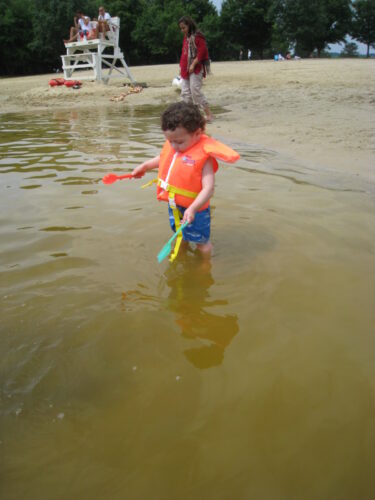The following is a guest post, and does not necessarily endorse the opinion of HaveSippyWillTravel nor myself.
Whether this is your first or fourth kid, the struggles of the newborn stage and the fact that you weren’t able to fly for the last few months of your pregnancy (or at least not without some concerns for overseas labor), means that you’re probably gasping for a vacation. Heck, you may even spend those late-night feeds researching accommodation and letting your cursor hover over that tempting ‘book now’ button. Only, you can’t quite bring yourself to commit because you can’t shake one pressing question – is your baby old enough for international travel?

After all, looking after a fresh baby can be hard enough at home, let alone when you’re factoring for things like flights, unfamiliar accommodation, and more. Admittedly, many parents claim that around 3-6 months is a great time for a baby’s first flight (certainly compared with the toddler years), but experts like Lonely Planet co-founder Maureen Wheeler recommend waiting until at least the age of three.
Realistically, though, no one can know the ‘right’ time better than you. So, instead of getting stuck in a constant back and forth about your first trip as an entire family, consider the following crucial elements that can highlight once and for all whether you’re all ready for traveling long-haul.
What would you need to take?
The days of slinging a few sandals and bikinis into a tote bag and jetting off are long behind you, but the amount of luggage you’ll need to take will still be dictated a great deal by the age of your youngest child. For instance, if you’re traveling when your baby is younger than a year, you’ll need to consider everything from sterilizers to bottles, travel cots, and of course, a single or double stroller (depending on how many children you’re taking along for the ride). All of this is cumbersome, and not exactly suitable for your hand luggage, meaning that you’ll likely need to check multiple items into the bag hold, often on a specialized basis. Not to mention that it’ll be much harder to get anywhere when you reach the airport at the other end. This can get pricey, not to mention stressful, but it’s something that you can significantly reduce by waiting even a year or, as Wheeler recommends, until the age of three when things like bottles, strollers, and cot sleeping will be well in your past.
Will the heat be a problem?
Heat should also always factor in your decision about whether or not travel is a good idea for a particularly young baby. After all, while people can and do manage in even extreme heat, it isn’t always fair or safe to impose this on a tiny baby. In fact, the American Academy of Pediatrics suggests avoiding taking a baby outside in a heat index greater than 90 degrees Fahrenheit. Ignoring this suggestion and going somewhere that’s continually hotter than this could result in an incredibly restless, unhappy baby, as well as opening the doors for worrying health conditions like heat stroke and sunburn. The good news is that these risks iron themselves out as babies learn to regulate their body heat through sweat, etc. by around 1.5 – 2 years old. Until then, though, heading somewhere hot could well end up being a horrible experience for everyone.
Will your child realistically remember the trip?
Especially if you’re paying extra to haul all of their stuff to your chosen destination, it’s also worth considering whether your child is going to remember/truly benefit from this experience. Of course, on the one hand, you’re also heading abroad for the sake of your sanity, but there’s little point in spending a small fortune on a once-in-a-lifetime trip to Barbados if there’s not even the slightest chance that your child is going to notice they’re anywhere different. In fact, until your baby begins to develop their awareness/form memories between the ages of two to three, you would be far better off getting an affordable vacation fix closer to home. Then, when your youngest is old enough to benefit from the experience, you’ll have a whole lot more money in the bank for everything from hiking trips to Nepal to a round-the-world trip to Europe that’s guaranteed to be unforgettable for everyone involved.
Putting travel aside for any period can be tough, especially if you’re dealing with the emotions and pressures of having a newborn. Unfortunately, jetting away isn’t always the answer, as you’ll see for yourself if you take the time to address these questions before you go.


 Was your child having difficulty managing at home or distance learning? Is he or she worried about going back to school? I can tell you, my youngest is in a panic about going back, he’s very worried. While at home learning was necessary for both the safety of the children and the teachers and staff, it has definitely had it’s negative effects on quite a few of the kids. Socialization, a sense of normalcy, routine, etc. Being stuck at home was hard on everyone, and it seems that the kids took it extremely rough. If your child is returning to school this fall, check out these tips from Dr. Bregman, child psychiatrist, starting next sentence.
Was your child having difficulty managing at home or distance learning? Is he or she worried about going back to school? I can tell you, my youngest is in a panic about going back, he’s very worried. While at home learning was necessary for both the safety of the children and the teachers and staff, it has definitely had it’s negative effects on quite a few of the kids. Socialization, a sense of normalcy, routine, etc. Being stuck at home was hard on everyone, and it seems that the kids took it extremely rough. If your child is returning to school this fall, check out these tips from Dr. Bregman, child psychiatrist, starting next sentence.














